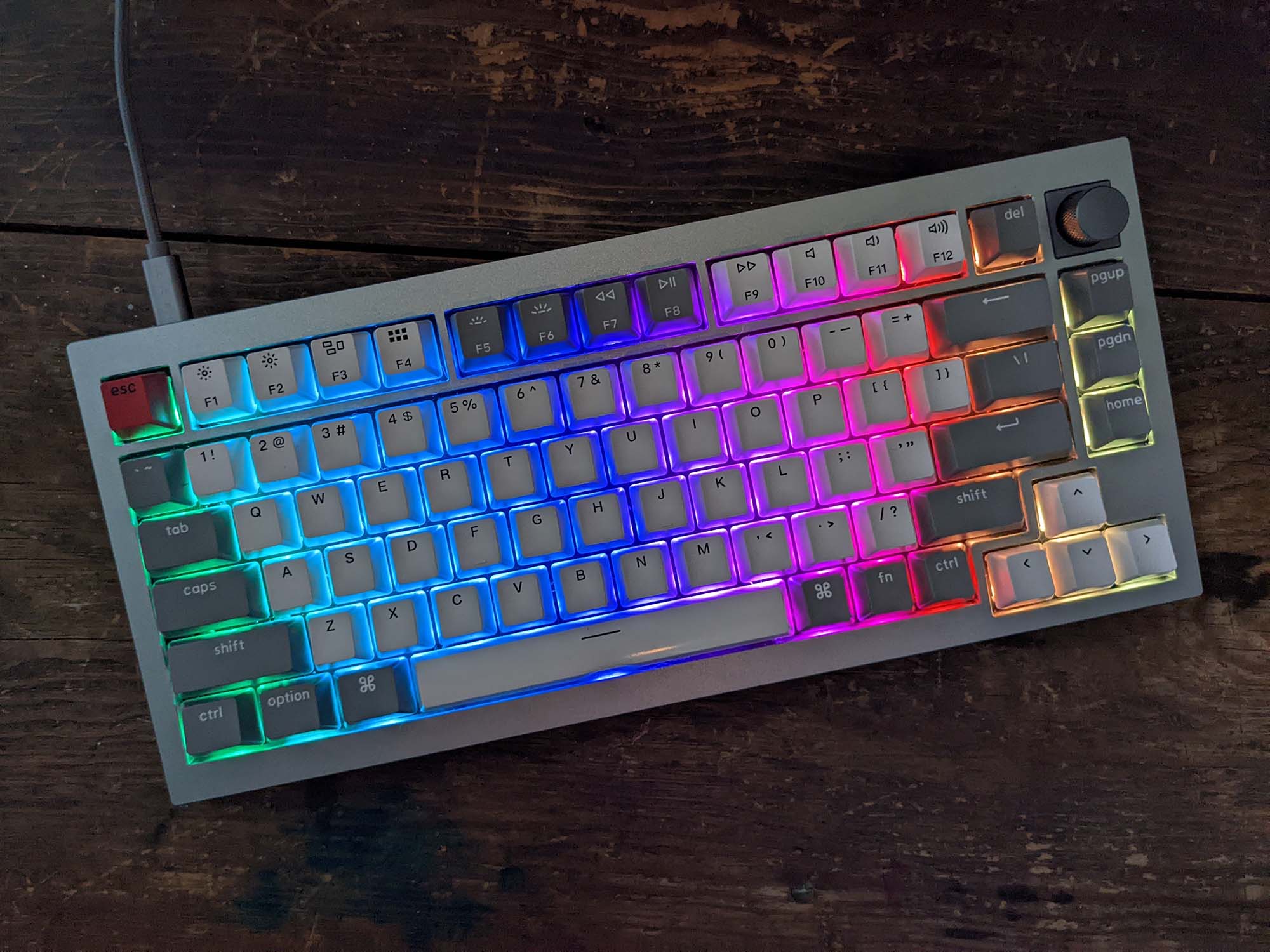

Let us guess: you saw a video on TikTok of people building vibrant, delicious-sounding mechanical keyboards and thought you’d get in on the fun. But all you found online were acronyms, dense subreddits, and 10-plus-minute YouTube videos on how complicated (and expensive) homemade mechanical keyboards can be.
Even though the community has become more welcoming to curious onlookers, it’s not easy to find basic information about the hobby. This is especially true if you haven’t given much thought to your keyboard in the first place, or if you still think the flimsy and unresponsive membrane keyboard on the MacBook Air is not that bad.
So before you fall down an internet rabbit hole trying to figure out what the colors on switches mean, let’s talk about what you really need to know about getting or building your own customizable mechanical keyboard. Maybe you’ll figure out why people are spending hundreds of dollars on them—and even decide they’re totally worth it.
Why are people buying mechanical keyboards?
The gaming community has been in on mechanical keyboards for a while now, as they can provide faster response times and an overall better playing experience. But if you only game on a console or only use your computer for work, you might have never wondered why people would spend money on a keyboard. Well, COVID-19 might have something to do with it.
[Related: The best mechanical keyboards let you game, code, type, and work smoother and faster]
“Keyboards have never been considered something to invest in, but with the help of everyone staying at home, people are starting to understand that you can make a keyboard a nice tool to work with instead of something that you buy off the shelf for very cheap,” says Taeha Kim, also known as Taeha Types, a custom mechanical keyboard builder and content creator.
In one of his videos, Taeha also points out that if we’re already spending money on more powerful machines and bigger, better displays, it makes sense to have a nice, comfortable keyboard to use with them. Especially if we’re typing most of the day, every day.
It’s all about customization
The main difference between a customizable mechanical keyboard and more basic devices is, well, that they’re customizable. But it’s not just about switching your keycaps—the external part of the keys you actually hit with your fingers—for something more colorful or comfortable. You could customize how your keyboard sounds, how hard you have to press each key to actuate it, how much that key “fights back” with each push, how many keys you want to have, and many other characteristics.
You can even remap your entire keyboard by erasing the default functions of any key and assigning it a completely different task. On top of that, you can include layers upon layers of macros and key combinations specific to you and your needs.
For remapping and creating macros, you’ll need an open-sourced program called Via. This free, easy-to-use software will give you access to your keyboard’s keymap, as well as information about everything each button does. Keep in mind that you can’t use VIA without a customizable keyboard, so make sure yours is compatible.
The anatomy of a mechanical keyboard
Because the customization possibilities are so vast, it can be easy to be overwhelmed by the number and variety of mechanical keyboard parts you can find online. But if you look at the bigger picture, a keyboard’s anatomy is not complicated at all.
Case
First, there’s the case, which is the actual body of the keyboard and can be made out of different materials, including wood. If you’re building your own mechanical keyboard, the case will always be the first thing you buy, as its size will determine the number and distribution of the keys (the form). For example, a full-sized keyboard, known as “a 100 percent,” will include a row of function (Fn) keys at the top, a numerical keypad on the right, and other useful buttons like “page down,” “home,” and “delete.” A 75 percent is what you see on most home laptop models, including the MacBook family, and there are even 55 percents, which essentially only include letters and other basic keys such as “return” and “control.”
The PCB and the plate
Inside the case, there are two parts: the printed circuit board (PCB) and the plate. The former is your keyboard’s brain, connects to your computer, and holds your switches (we’ll get to those in a moment). The plate, on the other hand, sits on top of the PCB and protects it from the elements—you can catch glimpses of it between your keycaps. But because the plate is in direct contact with the keycaps, it also provides part of the delicious sound we all want and love in a mechanical keyboard. Plates come in different materials, like brass, aluminum, or carbon fiber, and each material sounds different when hit with various keycaps.
Switches
The most intricate part of a keyboard may be the switches, and they are by far what confuse newcomers the most. In broad terms, switches are the buttons under the keycaps. They connect to the PCB through two or three copper connectors, and they’re mostly responsible for giving your keyboard a specific feel and sound. In general, you’ll find three main categories: linear, tactile, and clicky. The first one provides no feedback when it’s actuated or when the key is actually registered by your computer, while the second one provides tactile feedback (a little bump), and the third makes an extra click.
Although the industry and some people in the community have associated each type of switch to specific user profiles (linears are for gamers, clickies are for typists, etc), Taeha is adamant that your experience is unique to you.
“These are tools to get a certain task done. And everyone has different preferences. It’s just about finding the one that fits your needs,” he says.
Finding the right set of switches for you might take a while, and it’s critical that you try them—you can learn so much more from a hands-on experience than by reading any review. But before you order a couple sets, you might want to get a switch tester. These small boards come with different types of switches for you to try, and you can find them for as little as $7, depending on their size and where you buy them.
Still, testers won’t give you the full experience, so going to community events is a great way to get to know and try what’s out there. Taeha recommends you search for local groups of enthusiasts around you and check for any upcoming meetings. Keep in mind that these gatherings have become more and more scarce due to COVID, so you may have to wait a bit.
Keycaps
Finally, there are keycaps—the most visible part of your keyboard along with your case, and definitely the part where you can have the most fun. There are many types of keycaps, and the sky’s the limit when it comes to design—you can find them in colorful palettes, and even shaped like a cat’s paw pads.
Changing your keycaps may be the easiest customization you can do to your keyboard. They’ll change its look, provide a new tactile experience, and different profiles can even change the way you type. To swap out your keycaps, you’ll only need a tool called a keycap puller. And don’t forget to take a picture of your keyboard’s original layout before you start yanking it apart—it’ll help you immensely when you put your board back together.
Be aware of compatibility
Unfortunately, there are not a lot of manufacturing standards when it comes to keyboard parts. Every time you buy a new plate, set of switches, or keycaps, you’ll need to do your research and make sure the item you’re interested in is compatible with the setup you have at home.
It all starts with the type of keyboard you’re dealing with. There are two options available: hot-swappable and soldered. The former allows you to swap switches easily with only a switch puller, whereas the latter requires a soldering iron and some advanced skill to make any significant customization to how your keyboard feels and sounds.
Likewise, not all keycaps will fit your switches, and not all switches will fit into your PCB. Different colored switches also mean different things depending on the brand, so we cannot stress enough the importance of doing your homework before buying. Not doing so will likely result in both wasted money and much frustration. Even though massive online marketplaces like Amazon will have much of what you’ll need to build your keyboard, you’ll need to dig deeper if you want something slightly more unique or better quality. And because the hobby is driven mostly by small and local manufacturers, many of which fund their operations on Kickstarter, waiting months or even a year for a part to arrive is not uncommon, Taeha explains.
“That’s how you have access to more intricate and nuanced designs that might not be possible with mass production,” he says. “But you’re going to need a lot of patience.”
It’s OK to start small
If you’re intimidated, you’re not alone. There’s a lot of information out there and it’s easy to get dizzy. Plus, customizable mechanical keyboards and their parts are not exactly cheap, so this is not a buy-the-materials-and-figure-things-out-later kind of hobby.
Taeha recommends beginners start by getting a fully assembled keyboard and playing around with it by changing some of the parts. Eventually, you’ll get the hang of it and end up with either a highly customized board or the thirst of going for more. And if you want to go all-in from the get-go and build a board from scratch, you’ll need to plan ahead.
[Related: 20 essential Windows keyboard shortcuts that will make you forget your mouse]
“Anything between $150 and $200 is a great budget for your first build,” Taeha says. “You can end up with a nice keyboard you can upgrade later if you want.”
Still, he stresses the importance of research and recommends taking advantage of the current boom of mechanical keyboard content on platforms such as YouTube and TikTok.
“The best way to get into it at the moment is to just consume a lot of content,” he says. He also recommends diving into the r/MechanicalKeyboards subreddit and the old-looking but still fully functional geekhack.org. There you’ll find more nuanced information and details on parts and building, and even get in on the crowdsourcing, kick-starting, group-buying fun.















